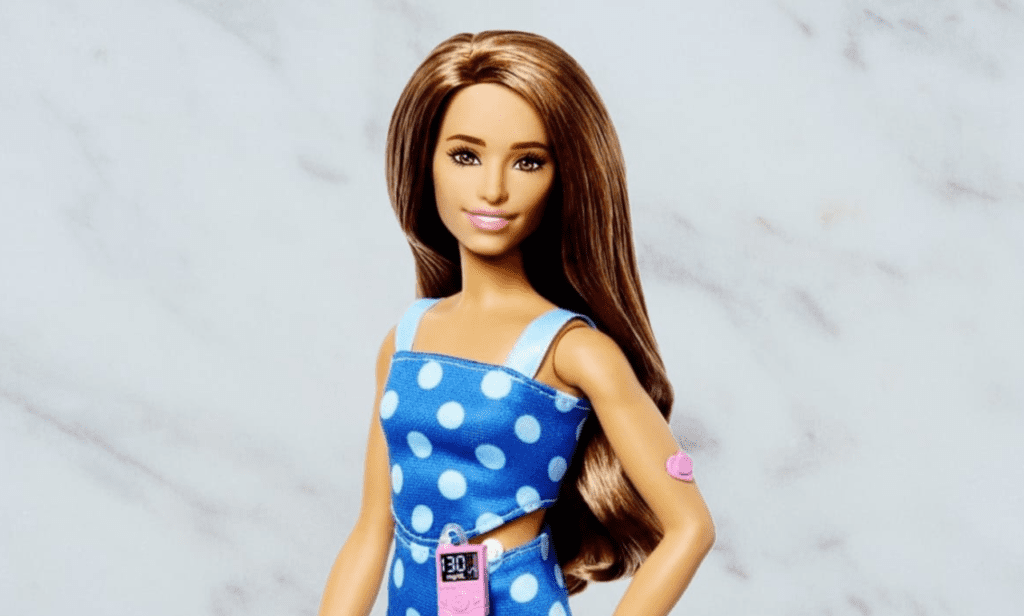
Paragraph 1
When 8-year-old Mia unboxed her new Barbie last month, she did something extraordinary: she clipped a miniature continuous glucose monitor (CGM) onto the doll’s arm, mirroring her own medical device. This seemingly simple act represents a seismic shift in childhood play. Mattel’s Type 1 Diabetes Barbie, developed with JDRF (Juvenile Diabetes Research Foundation), isn’t just another toy—it’s a validation for the over 352,000 American children under 20 managing this chronic condition. Complete with scientifically accurate accessories—a working insulin pump, blood glucose meter, and carb-counting guide—this doll transforms medical equipment from sources of shame into symbols of strength. Pediatric psychologist Dr. Anika Patel observes: “For the first time, kids see their diabetes tools normalized in mainstream culture through the world’s most iconic toy.”
Paragraph 2
The emotional significance of this representation can’t be overstated. Children with type 1 diabetes perform approximately 180 health-related tasks weekly—from finger pricks to insulin calculations—often while navigating playground stigma. A 2024 Lancet Child & Adolescent Health study revealed 68% of children with visible medical devices experience bullying. “Before this Barbie, my daughter would hide her insulin pump under baggy clothes,” shares single father David Rivera, whose 7-year-old was diagnosed at three. “Now she dresses her doll in crop tops to proudly display the pump. That’s revolutionary.” The doll’s accessories were meticulously designed by JDRF’s medical team, with insulin pods that magnetically attach to the abdomen and a CGM sensor replicating real-time monitoring systems used by millions.
Paragraph 3
Mattel’s initiative addresses a glaring representation gap. According to the Toy Association’s 2024 Diversity Audit, less than 2% of dolls feature any disability or health condition, despite 1 in 4 Americans living with disabilities. Meanwhile, type 1 diabetes diagnoses in children are surging—up 45% globally since 2010 (IDF Diabetes Atlas). “The healthcare industry has long understood ‘medical play’ as therapeutic,” explains child life specialist Maria Hernandez of Boston Children’s Hospital. “We’ve used generic dolls with tape-on devices for years. But when Mattel puts Barbie’s cultural weight behind this? It signals to kids that their reality matters.” Hernandez’s team now uses the doll during diagnosis education, helping children role-play injections and glucose checks to reduce procedure anxiety.
Paragraph 4
Beyond individual impact, the doll sparks crucial family conversations. When 10-year-old Leo received the Barbie for his sister who has diabetes, he asked, “Why does she need that robot arm?”—leading to his first genuine discussion about autoimmune conditions. Educational psychologist Dr. Liam Foster notes: “Siblings often feel confused or neglected. This doll becomes a neutral conversation starter that benefits entire family dynamics.” The ripple effects extend to classrooms too. Teachers in Australia’s “Diabetes in Schools” program report a 40% increase in peer understanding when using the doll during health education, according to 2025 data from the National Diabetes Services Scheme.
Paragraph 5
Criticism emerged initially about “medicalizing” childhood play. Some worried it might commercialize serious health conditions. Disability advocate Michaela O’Donnell, who has lived with type 1 diabetes for 28 years, counters: “This isn’t exploitation—it’s visibility. We’re not asking for ‘special’ dolls, just equal representation.” Mattel’s pricing strategy supports this: at $24.99, it costs the same as standard Barbies. The company also consulted over 200 families during development, ensuring authenticity. “The carb-counting booklet isn’t a prop,” emphasizes O’Donnell. “It’s modeled after actual pediatric diabetes education materials. That attention to detail tells kids their experience is respected.”
Paragraph 6
The economic accessibility of medical devices plays a subtle but powerful role in the doll’s design. Real-world CGMs and insulin pumps can cost families thousands annually—a financial burden highlighted by the miniature versions’ inclusion. “When low-income children see Barbie with the same devices they’re denied due to insurance gaps, it sparks important questions about healthcare equity,” observes health policy expert Dr. Raymond Chen. This symbolism isn’t lost on advocacy groups. The Diabetes Patient Advocacy Coalition has begun sending the dolls to legislators with notes reading: “Every child deserves Barbie’s healthcare.”
Paragraph 7
Psychologically, the doll leverages “narrative identity theory”—the concept that children build self-understanding through stories. “Kids literally rewrite their medical journey through play,” explains Dr. Elena Rodriguez of Stanford Children’s Health. Her 2025 study in Pediatrics tracked 100 children with diabetes engaging in medical doll play. Results showed a 32% decrease in self-reported shame and a 27% increase in treatment adherence over six months. One participant, 9-year-old Elijah, began calling his insulin pod his “power pack” after giving Barbie identical gear. “That reframing is clinically significant,” Rodriguez stresses. “When medical devices become part of a heroic narrative versus a defect, resilience follows.”
Paragraph 8
The doll’s cultural timing is critical. Gen Alpha (born 2010-2024) is projected to be the most health-diverse generation in history, with rising rates of autoimmune conditions and neurodiversity. Mattel confirms this Barbie spearheads their “Fashionistas Medical Heroes” line, with dolls featuring asthma inhalers, hearing aids, and mobility aids in development. “We’re finally moving beyond tokenism,” says inclusive play consultant Jamal Wright. “The 1997 ‘Share a Smile Becky’ wheelchair Barbie was groundbreaking but felt like a checkbox. This new generation integrates medical tools into play scenarios organically—Barbie isn’t ‘inspirational,’ she’s adventuring while managing health.”
Paragraph 9
Global response reveals fascinating cultural nuances. In Japan, where diabetes carries heavy stigma, sales surpassed projections by 300%. The UK’s National Health Service is piloting the doll in 120 clinics after trials showed it reduced pediatric diabetes distress by 41%. Even healthcare professionals benefit: endocrinologist Dr. Priya Mehta shares, “My youngest patients now teach me how they ‘fix’ Barbie’s blood sugar. That role reversal builds therapeutic trust you can’t achieve in traditional consultations.”
Paragraph 10
Ultimately, this Barbie’s genius lies in its simplicity. No lectures about insulin resistance—just a fashionable doll checking her glucose monitor between adventures. As 6-year-old Zoe told her mother while adjusting her Barbie’s insulin pump: “She’s not sick, Mommy. She’s just checking her superpowers.” In that unscripted moment, plastic becomes profound. The doll accomplishes what medical pamphlets cannot: transforming difference into pride, one play session at a time. For millions of children, Barbie’s tiny medical devices aren’t limitations—they’re launchpads for self-acceptance in a world learning to embrace health diversity.
